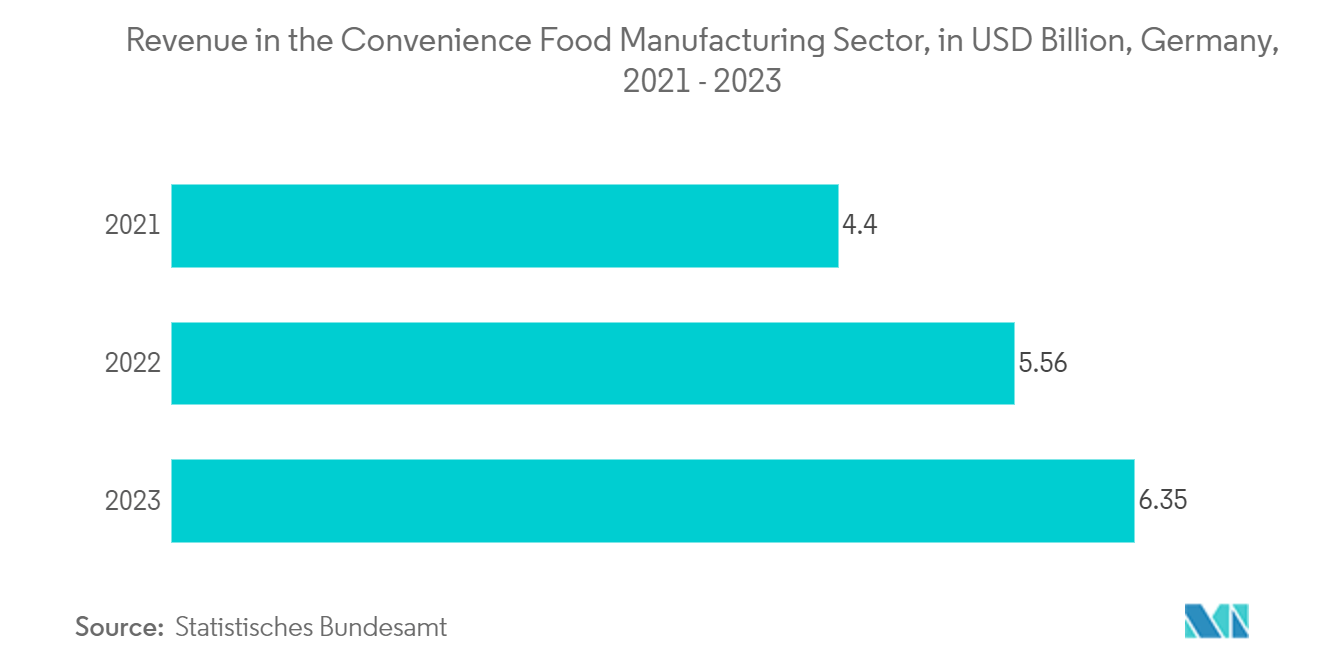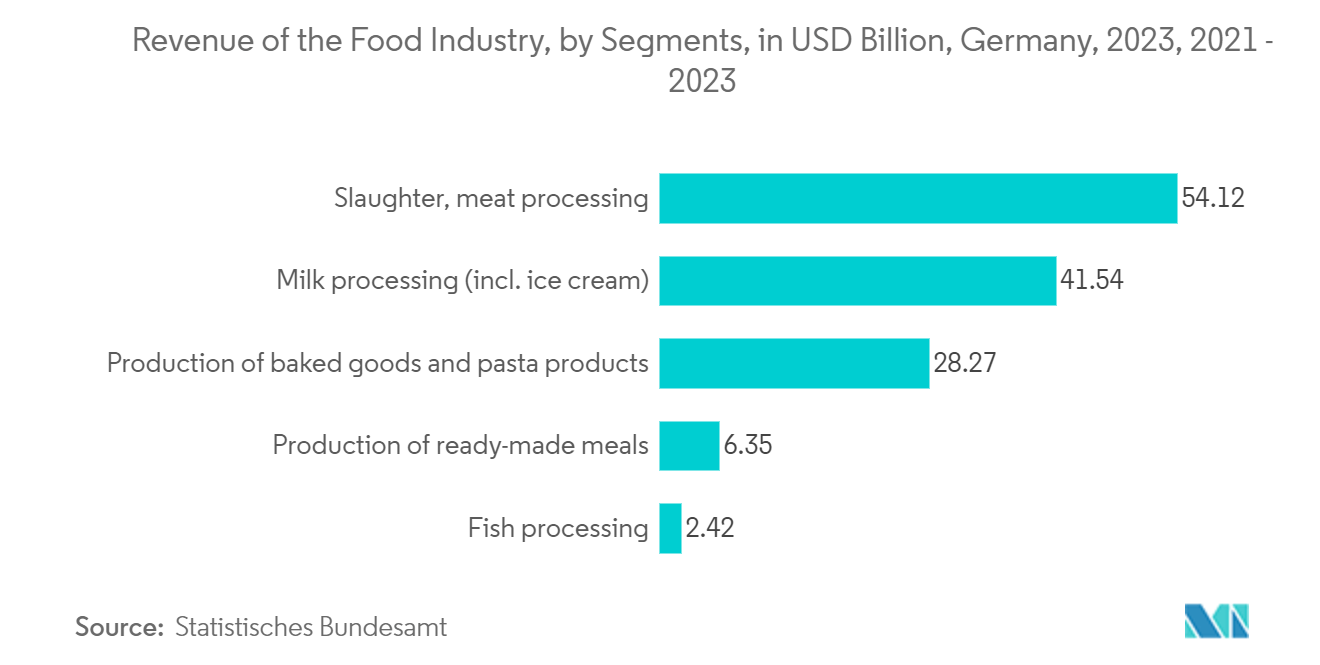Market Trends of Europe Food Contract Manufacturing & Packaging Industry
Processing & Manufacturing to Hold Significant Market Share
- The demand for contract food processing and manufacturing services in Europe is surging, mainly due to a rising preference for private-label products. Supermarkets and retail chains are turning to contract manufacturers for food production, allowing them to present cost-effective, high-quality items under their brands. This shift gains prominence as consumers increasingly gravitate towards private-label goods, drawn by their competitive pricing and quality akin to branded counterparts. Consequently, food manufacturers are stepping up to meet the expansive production demands of these retailers, all while ensuring consistent quality and strict adherence to food safety standards.
- Health and wellness trends fuel this demand, with consumers actively seeking healthier, functional food choices. Preferences are shifting towards plant-based, gluten-free, low-sugar, and high-protein options. This evolution is pushing food manufacturers to adjust their production capabilities. Contract manufacturers, especially those offering flexibility in small-batch runs, specialized formulations, and swift production turnarounds, are becoming indispensable as brands venture into the health-centric food arena. The knack for producing niche-specific products is emerging as a pivotal determinant of success for food brands, amplifying the demand for contract manufacturing services.
- Sustainability is emerging as a pivotal driver for the uptick in contract manufacturing demand across Europe. With consumers and regulatory entities urging food companies to curtail their environmental footprint, manufacturers championing eco-friendly packaging, sustainable sourcing, and waste minimization are witnessing heightened demand.
- Moreover, the e-commerce boom and the surge in direct-to-consumer food sales are prompting contract manufacturers to devise innovative packaging solutions and navigate the intricacies of online food retail logistics. This evolution underscores the growing need for food manufacturers adept at delivering sustainable, scalable production solutions while aligning with consumer expectations for quality and environmental stewardship.
- Germany's Convenience Food Manufacturing Sector has seen its revenue climb steadily from 2021 to 2023, underscoring a burgeoning appetite for convenient food products. Starting at USD 4.40 billion in 2021, the sector's revenue jumped to USD 5.56 billion in 2022, and further ascended to USD 6.35 billion in 2023.
- This upward trajectory signals that Germany's convenience food manufacturing is riding the wave of robust consumer demand. Factors such as increasingly hectic lifestyles, urbanization, and shifting eating habits have fueled the appetite for ready-to-eat meals, quick snacks, and frozen foods. Additionally, the industry's growth is buoyed by trends emphasizing health-conscious choices, sustainable packaging, and the surging popularity of online grocery shopping.
- The revenue surge in Germany's convenience food sector highlights its responsiveness to consumer needs and evolving dietary trends. These trends increasingly favor healthier, plant-based, and allergen-free options. This growth trajectory remains strong, with manufacturers prioritizing innovation and attuning to the European market's changing demands.

Germany to Show Significant Growth
- Germany's Food Contract Manufacturing & Packaging Market is on an upward trajectory, fueled by several pivotal factors. As consumers juggle busier lifestyles, there's a pronounced surge in demand for convenience and ready-to-eat products. This shift compels companies to turn to contract manufacturers and packaging experts adept at delivering high-quality, ready-to-consume food items. Furthermore, an increasing emphasis on health-conscious, organic, and functional foods is paving the way for specialized manufacturing services.
- The escalating demand for food processing and manufacturing is another driving force behind the market's expansion. With food preferences diversifying, especially toward plant-based, organic, and functional foods—manufacturers are leaning more toward contract services for processing, packaging, and delivering premium products. This reliance on contract manufacturing enables companies to cater to the rising demand for niche products without the hefty investment in production facilities. This trend is evident in sectors like alternative protein sources, dietary supplements, and ready-made meals.
- The booming e-commerce landscape and the surge in direct-to-consumer food sales have amplified the need for specialized packaging that safeguards product integrity during transit. As online food purchases soar, there's a heightened demand for packaging solutions that are both protective and visually appealing. Services like meal kit deliveries and online grocery shopping underscore the necessity for efficient, high-quality packaging tailored for long-distance shipping.
- Technological advancements are revolutionizing the food manufacturing and packaging sectors. Techniques like modified atmosphere packaging (MAP), vacuum sealing, and innovative packaging are becoming popular for their prowess in extending shelf life and maintaining food quality. Moreover, infusing automation and digitalization into production boosts efficiency and customization. This evolution empowers manufacturers to cater to various food categories, from established ones to emerging trends like plant-based and functional foods. Such innovations amplify the demand for contract manufacturing services that promise creativity and scalability.
- Germany's food industry is witnessing robust revenues across its processing segments, significantly influencing the Food Contract Manufacturing & Packaging market. Leading sectors, such as slaughter and meat processing (USD 54.12 billion) and milk processing, including ice cream (USD 41.54 billion), are turning to advanced contract manufacturing and packaging solutions. These solutions cater to the soaring demand for traditional and processed food items. For instance, meat processors depend on contract manufacturers for specialized packaging that ensures safety, prolongs shelf life, and adheres to strict food safety standards. Likewise, as the appetite for premium, ready-to-consume dairy products surges, dairy producers are increasingly collaborating with contract manufacturers to produce and pack milk, cheese, and ice cream.
- Baked goods and pasta production (USD 28.27 billion) also leans heavily on contract manufacturing and packaging. These services ensure efficient output and innovative packaging that preserves freshness and visual appeal. With a rising consumer appetite for ready-made meals (USD 6.35 billion), contract manufacturers are pivotal, delivering swift, top-notch meal production and specialized packaging that safeguards products during transit and storage. Furthermore, fish processing (USD 2.42 billion) reaps the benefits of contract manufacturers, overseeing everything from production to packaging, especially for frozen, canned, or ready-to-eat offerings. In summary, Germany's food industry's expansion and variety underscore a growing demand for contract manufacturing and packaging services. Companies are increasingly pursuing these specialized, cost-effective solutions to boost production, enhance efficiency, and align with consumer expectations.


